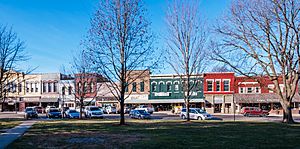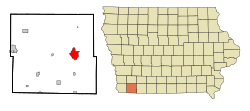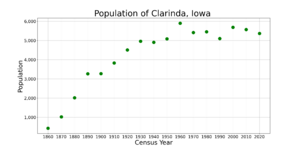Clarinda, Iowa facts for kids
Quick facts for kids
Clarinda, Iowa
|
|
|---|---|
 |
|
| Motto(s):
"Honor the Past...Imagine the Future"
|
|

Location within Page County and Iowa
|
|
| Country | |
| State | |
| County | Page |
| Area | |
| • Total | 5.13 sq mi (13.29 km2) |
| • Land | 5.10 sq mi (13.21 km2) |
| • Water | 0.03 sq mi (0.09 km2) |
| Elevation | 1,027 ft (313 m) |
| Population
(2020)
|
|
| • Total | 5,369 |
| • Density | 1,052.75/sq mi (406.46/km2) |
| Time zone | UTC-6 (CST) |
| • Summer (DST) | UTC-5 (CDT) |
| ZIP code |
51632
|
| Area code | 712 |
| FIPS code | 19-13575 |
| GNIS ID | 2393534 |
Clarinda is a city in Page County, Iowa, United States. It is also the county seat, which means it's where the main government offices for the county are located. In 2020, about 5,369 people lived here.
Contents
History of Clarinda
Clarinda was started in 1851 and officially became a city on December 8, 1866. There are many stories about famous people like Jesse James often passing through the area.
The town got its name from Clarinda Buck. Legend says she carried water to the people who were surveying the land for Page County a long time ago.
For many years, a well-known company in Clarinda was Berry's Seed Company. It was a business that sold farm seeds by mail order, started in 1885 by A. A. Berry. Today, the company is called Berry's Garden Center and operates from one store in Illinois.
During World War II in 1943, a special camp was built in Clarinda. This camp was for prisoners of war, and it could hold up to 3,000 people. Prisoners from Germany arrived first, and later, prisoners from Italy and Japan were also held there.
A part of Clarinda in the southeast was once called "Gun Town," and some people still use that name today. It was a very busy area in the 1920s and 1930s, full of businesses like grocery stores, restaurants, and even a rug factory. It was a lively part of the city!
Getting Around Clarinda
Roads and Highways
Clarinda is located on US Highway 71 and Iowa Highway 2. These highways used to go right through the middle of town. Now, there's a bypass that takes both highways around the south and east sides of Clarinda. There are also many county roads that connect farms to the market and other areas.
Train Service
A long time ago, Clarinda had train tracks coming from seven different directions! Most of these were part of the Chicago, Burlington, and Quincy Railroad. Over the years, many of these train lines were removed. By the 1980s, Clarinda no longer had any train service. The old brick train station in Clarinda is still standing and is now used as the Student Union for the Iowa Western Community College campus.
Air Travel
The town has its own airport called Schenck Field. It's named after Ray Schenck, a farmer and pilot who built the first airport in Clarinda on that spot.
Clarinda's Geography
Clarinda is located right next to the West Nodaway River. It's just north of where the West Nodaway River meets the East Nodaway River.
The city covers about 5.22 square miles (13.52 square kilometers) in total. Most of this area is land, with a small part being water.
Clarinda's Climate
Clarinda experiences all four seasons. Summers are generally warm, and winters can be cold with snow. The city gets a good amount of rain throughout the year.
People of Clarinda
| Historical population | |||
|---|---|---|---|
| Census | Pop. | %± | |
| 1860 | 427 | — | |
| 1870 | 1,022 | 139.3% | |
| 1880 | 2,011 | 96.8% | |
| 1890 | 3,262 | 62.2% | |
| 1900 | 3,276 | 0.4% | |
| 1910 | 3,832 | 17.0% | |
| 1920 | 4,511 | 17.7% | |
| 1930 | 4,962 | 10.0% | |
| 1940 | 4,905 | −1.1% | |
| 1950 | 5,086 | 3.7% | |
| 1960 | 5,901 | 16.0% | |
| 1970 | 5,420 | −8.2% | |
| 1980 | 5,458 | 0.7% | |
| 1990 | 5,104 | −6.5% | |
| 2000 | 5,690 | 11.5% | |
| 2010 | 5,572 | −2.1% | |
| 2020 | 5,369 | −3.6% | |
| U.S. Decennial Census | |||
2020 Census Information
In 2020, there were 5,369 people living in Clarinda. Most of the people living in Clarinda were White (about 86.6%). There were also people who identified as Black or African American, Native American, Asian, and people of two or more races. About 3.5% of the population was Hispanic or Latino.
The average age of people in Clarinda was 40 years old. About 21% of the residents were under 20 years old.
2010 Census Information
In 2010, Clarinda had 5,572 people. The population was mostly White (about 89.2%). About 21% of the people were under 18 years old.
Clarinda's Economy
Clarinda has a few important businesses.
- NSK-AKS is a company that makes parts for machines, like ball and roller bearings.
- Lisle Corporation started in Clarinda in 1903. They make hand tools and special equipment for car mechanics.
- The Clarinda Treatment Complex is a large center on the north side of the city. It helps people with mental health needs. It was first opened in 1884.
Sports in Clarinda
Clarinda is home to the Clarinda A's, a summer amateur baseball team. This team was started by Merl Eberly. In 1981, they won the National Baseball Congress championship! Several players from the Clarinda A's have gone on to play in the major leagues. One famous player is Baseball Hall of Fame member Ozzie Smith, who often comes back to Clarinda for special events.
Before the Clarinda A's, the city also had minor league baseball teams, like the Clarinda Antelopes in 1910-1911.
Iowa Western Community College also had very successful junior college baseball teams from 1982 to 1984. These teams won many games and were ranked high nationally. Many players from these teams were drafted to play professional baseball or continued their college careers at big universities.
Education in Clarinda
The Clarinda Community School District serves the students living in Clarinda.
Clarinda also has a campus of Iowa Western Community College, where students can continue their education after high school.
Clarinda's Infrastructure
State Facility
Clarinda is home to the Clarinda Correctional Facility, which is a state facility for adults who have committed crimes.
Bus Service
You can get daily bus service to Clarinda through Jefferson Lines. The bus stop connects buses traveling between Sioux Falls and Kansas City.
Notable People from Clarinda
- Vernon Baker, a hero from World War II who received the Medal of Honor.
- Edwin Harris Colbert, a scientist who studied ancient fossils (a paleontologist).
- Aletha June Franklin, a politician and activist for civil rights.
- William Peters Hepburn, who served as a U.S. representative.
- Norman Maclean, the author of the famous book A River Runs Through It.
- Marilyn Maxwell, a singer and film actress.
- Glenn Miller, a famous big band leader from the 1940s.
- Jessie Field Shambaugh, who founded the 4-H organization.
Images for kids
See also
 In Spanish: Clarinda (Iowa) para niños
In Spanish: Clarinda (Iowa) para niños






